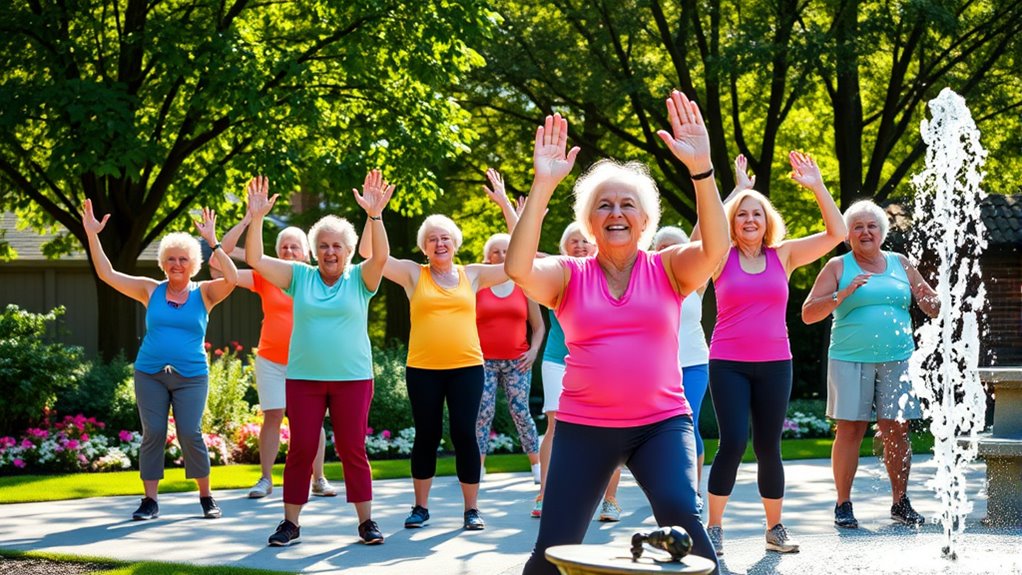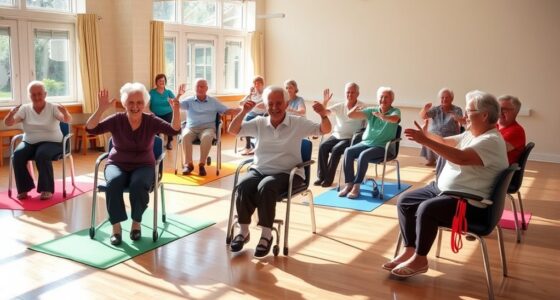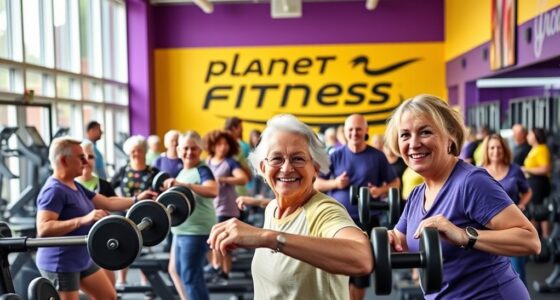To enhance your health and independence, warm-up and cool-down exercises are essential; they boost flexibility and reduce injury risks. Incorporate total body and functional movements into your routine to improve strength and mobility. Focus on upper body workouts and balance training, as these are crucial for preventing falls. Setting achievable fitness goals keeps you motivated, while community engagement adds a social aspect. If you want to discover more secrets to senior fitness, continue exploring our insights.
Key Takeaways
- Prioritize warm-up and cool-down exercises to enhance flexibility, reduce injury risk, and aid muscle recovery as you age.
- Incorporate total body and functional movements into routines to improve strength, balance, and independence for daily activities.
- Regular balance training can significantly reduce fall risks, improving your stability and confidence in everyday tasks.
- Set specific, measurable fitness goals to stay motivated and accountable in your exercise routine.
- Engage in community fitness activities for social support, enhancing motivation and making workouts more enjoyable.
The Importance of Warm-Up and Cool Down Exercises

When you commence on any workout routine, warming up and cooling down are essential steps that shouldn’t be overlooked.
Warm-up exercises, like shoulder mobility and dynamic one-leg hinges, enhance your flexibility and prepare your body for physical activity. This preparation reduces the risk of injury during workouts. Incorporating consistent warm-up routines improves circulation and increases your joints’ range of motion, which is vital as you age. Additionally, engaging in activities that promote digital literacy programs can help seniors stay connected and motivated during their fitness journey. Moreover, maintaining flexibility is crucial for seniors as it helps in preventing injuries and enhances overall physical performance. Regular stretching can also contribute to better overall health, similar to how baked kale provides essential nutrients. Furthermore, creating transformative living spaces can encourage seniors to stay active and engaged.
Furthermore, participating in regular physical activity can help reduce anxiety and improve overall mental well-being.
After your workout, engaging in a proper cool down, such as bent over T rotations, aids muscle recovery and maintains flexibility. It’s important to recognize individual flexibility levels during cooldowns, allowing you to enhance mobility safely without overexerting yourself.
Key Total Body Movements for Seniors
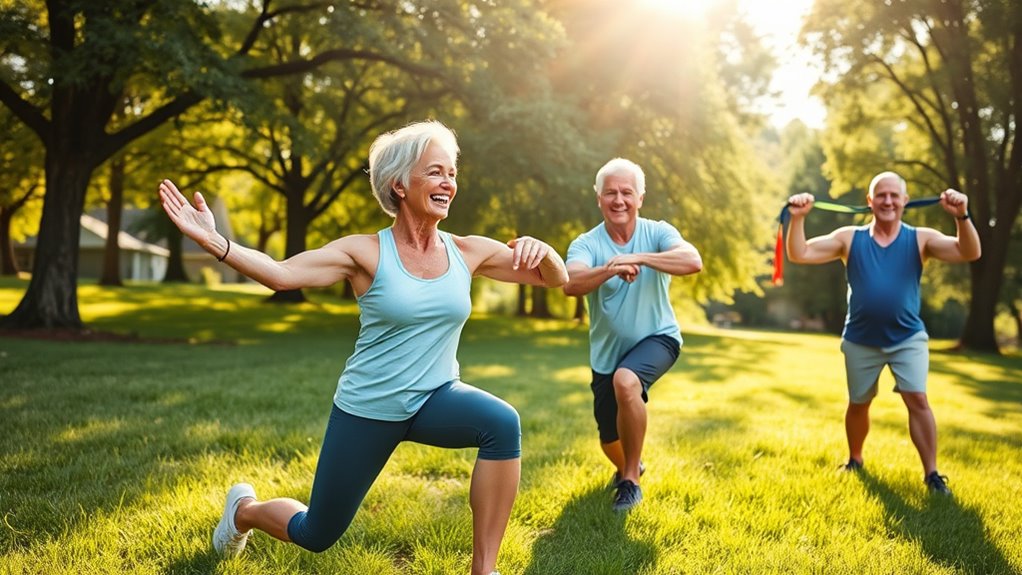
Total body movements are essential for seniors looking to enhance their strength, balance, and overall mobility. Incorporating exercises like the split knee drive engages your core and promotes functional balance, which is critical for daily activities. Regular veterinary check-ups ensure any underlying health issues are addressed, allowing for a more active lifestyle. Additionally, establishing clear retirement savings goals can provide peace of mind, enabling you to focus on your fitness journey. A well-rounded fitness routine should also consider contrast ratios to ensure optimal performance and safety during exercises.
The seesaw row strengthens your upper back and arms while emphasizing good posture, helping to prevent falls. Combination movements, such as the arm crossover with butt kick, improve coordination and rhythm, important for maintaining body control as you age. Furthermore, regularly reviewing your fitness routine can help ensure it aligns with your evolving health needs.
Single leg marches mimic running patterns and boost balance, fostering a stronger mind-muscle connection. Finally, chair squats and side-to-side punches target lower body strength and core engagement, supporting your independence in everyday tasks and overall physical health. Additionally, routine health checks can significantly contribute to identifying any potential issues early, ensuring you stay active and healthy.
Strengthening Upper Body With Effective Techniques

Building on the foundation of total body movements, focusing on upper body strength can further enhance your overall fitness and daily functionality. Engaging in exercises like the seesaw row greatly improves your posture and reduces the risk of shoulder injuries. Regularly incorporating the practice of mindful decluttering in your environment can also create a more focused space for your workouts, enhancing your overall motivation. Socialization at puppy training classes can parallel the importance of engaging with others during fitness routines to enhance motivation and accountability.
Incorporate dumbbell curls with alternating kicks to boost both upper body strength and lower body engagement, promoting better balance. Performing side-to-side punches strengthens your arms while engaging your core, enhancing stability for everyday activities. Additionally, utilizing high-low rope pulls effectively engages multiple muscle groups, fostering overall upper body strength. Regularly practicing these techniques will help you maintain mobility and independence, ensuring that you can enjoy life to the fullest as you age. Furthermore, solar technology can be a valuable investment in your home, providing sustainable energy solutions that support a healthier lifestyle. open dialogue is essential for maintaining healthy relationships and can encourage accountability in your fitness journey. Understanding your credit score can play a vital role in financial planning for healthcare and fitness needs as you grow older.
Enhancing Balance and Coordination

Enhancing your balance and coordination is essential for maintaining independence as you age.
By incorporating targeted exercises into your routine, you can improve your stability and functional abilities for daily activities. Engaging in regular balance training can also help you protect emotional health by reducing the fear of falling and enhancing your overall confidence. Additionally, practicing exercises that focus on functional abilities can further support your daily movements and activities. Incorporating primitive weapons skills into your routine can also boost your coordination and self-reliance in various situations. Regular balance training has been shown to significantly reduce the risk of falls in seniors, which can lead to serious injuries and decreased independence. Furthermore, maintaining a strong support network can also act as a foundation for emotional well-being during this phase of life.
Let’s explore the benefits of balance training and coordination exercises to help you stay active and confident.
Importance of Balance Training
As you age, maintaining your balance becomes increasingly important, especially since falls can lead to serious injuries. One in four seniors experiences a fall each year, making balance training essential for reducing that risk.
By engaging in balance exercises, you can improve your stability and coordination, which are key to staying independent in daily activities. Incorporating functional movements like single-leg marches and chair squats into your routine enhances your ability to perform everyday tasks safely. Additionally, focusing on high vibrational energy can further support your overall physical wellness and balance. Regular check-ins with healthcare professionals can also ensure you are on the right track with your fitness routine. It’s beneficial to consider state-specific retirement programs, as they can provide additional resources that support your health and fitness journey. An understanding of financial metrics can also help seniors budget for fitness programs that enhance their mobility and independence.
Studies show that regular balance training can boost your balance capabilities by up to 30%, while also strengthening lower body muscles and improving core stability. Prioritizing balance training now can help you maintain control and prevent falls in the future. Additionally, focusing on community resilience can provide a supportive environment that encourages safe practices and shared learning among seniors.
Coordination Exercises Benefits
Coordination exercises play an essential role in helping seniors improve their balance and stability. By engaging in activities like single-leg marches or arm-leg movements, you can enhance your neuromuscular connections, reducing your risk of falls by up to 30%.
These coordination exercises boost your proprioception, leading to better body awareness and control. Regular practice also influences gait stability, which is vital for maintaining your independence.
As you improve your coordination, you’ll gain greater confidence in your movements, allowing you to participate more actively in social and physical activities.
Plus, studies show that coordination exercises can enhance cognitive function, providing your brain with the mental challenges it needs.
Daily Activities Integration
Integrating balance and coordination exercises into your daily activities can make a significant difference in your overall stability and functional movement.
Simple actions like single-leg marches and arm-leg movements can enhance your mobility and flexibility while reducing fall risks.
Try incorporating dynamic movements, such as split knee drives or arm crossovers with butt kicks, to engage multiple muscle groups and boost your strength.
Activities like chair squats and side-to-side punches mimic real-life tasks, helping you gain confidence in your abilities.
Don’t forget to include warm-up and cool-down exercises focusing on flexibility, like shoulder box exercises, to improve joint function.
Regularly mixing in brain exercises can also sharpen your mind-muscle connection, further enhancing your balance and coordination for a more active lifestyle.
Functional Movements for Daily Activities

When you engage in functional movements, you’re not just exercising; you’re preparing your body for everyday activities. Movements like split knee drives and chair squats mimic actions such as walking and climbing stairs, enhancing your mobility and independence.
Incorporating total body movements, like arm crossovers with butt kicks, improves your coordination and balance, essential for preventing falls. Strength exercises, like dumbbell curls combined with low kicks, build muscle and support vital tasks, like lifting groceries.
Additionally, adding balance drills, such as single-leg marches, can greatly boost your stability, reducing injury risk. Regular practice of these functional movements can increase your confidence in routine tasks, promoting a more active and fulfilling lifestyle.
Specific Exercises to Target Major Muscle Groups

Targeting major muscle groups is essential for maintaining strength and functionality as you age. Incorporating chair squats effectively engages your glutes, hamstrings, and quadriceps, promoting lower body strength and stability.
To enhance your upper body strength, try the seesaw row, which focuses on your upper back and arms while emphasizing good posture. For a full-body workout, combine an arm crossover with butt kicks; this not only improves coordination but also engages your core.
Enhance upper body strength with seesaw rows and boost coordination with arm crossovers and butt kicks for a full-body workout.
Single leg marches mimic running patterns, boosting balance and stability. Finally, utilizing dumbbell curls with alternating kicks strengthens your arms and actively involves your lower body, reinforcing overall muscular fitness.
These exercises will help you stay strong and functional in your daily activities.
Setting and Achieving Fitness Goals

Setting fitness goals is essential for maintaining motivation and accountability, especially as we age. By setting clear objectives, you can stay focused and track your progress.
Here’s how to effectively set and achieve your fitness goals:
- Make them SMART: Guarantee your goals are Specific, Measurable, Achievable, Relevant, and Time-bound.
- Assess regularly: Check your progress often and adjust your goals as needed to stay challenged and motivated.
- Track your progress: Use journals or fitness apps to celebrate milestones and reinforce positive behavior.
- Establish a routine: Create a consistent workout schedule that includes strength, balance, and flexibility exercises for overall health improvement.
The Role of Community Engagement in Fitness
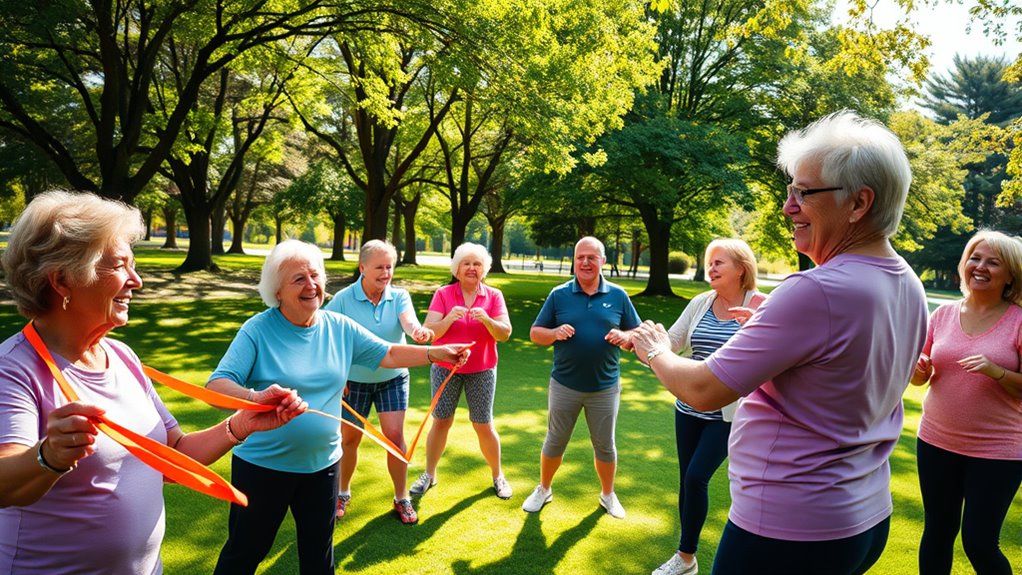
While you may find it challenging to stay motivated on your fitness journey, engaging with a community can greatly enhance your experience.
Community engagement fosters social connections, boosting your motivation and helping you stick to your exercise routine. When you participate in group activities, you’ll likely experience increased enjoyment and satisfaction, reducing feelings of isolation.
Plus, working out with others creates accountability, encouraging you to set and achieve personal fitness goals together. Research shows that seniors involved in community fitness programs enjoy better physical health and lower rates of chronic diseases.
Finally, these social interactions can improve your mental health by reducing stress and anxiety, making your fitness journey even more rewarding.
Health Benefits of Regular Exercise

Regular exercise offers a multitude of health benefits, especially for seniors looking to maintain their energy.
By incorporating regular physical activity into your routine, you can enjoy:
- Reduced risk of chronic diseases: Regular exercise improves circulation and metabolic function, lowering the chances of heart disease, diabetes, and certain cancers.
- Enhanced mental well-being: Physical activity releases endorphins, helping alleviate symptoms of anxiety and depression.
- Improved bone density and muscle strength: Regular exercise reduces the risk of falls and fractures, keeping you more stable.
- Better sleep quality: Engaging in exercise helps you fall asleep faster and enjoy deeper, more restorative sleep.
Embracing these health benefits of regular exercise can greatly improve your quality of life as you age.
Staying Consistent and Tracking Progress
Staying consistent with your exercise routine is key to reaping its benefits. By setting achievable goals and regularly monitoring your progress, you can keep your motivation high and see real improvements.
Let’s explore how establishing a routine and tracking your physical advancements can make a significant difference in your fitness journey.
Importance of Routine
Establishing a consistent workout routine is essential for enhancing your strength, balance, and overall fitness, especially as you age. Staying committed to a regular routine can greatly reduce your risk of chronic diseases and help maintain your independence.
Here are a few tips to keep you on track:
- Set a schedule: Allocate specific days and times for your workouts.
- Track progress: Document your achievements, whether it’s increased weights or improved endurance.
- Join a group: Participate in community fitness programs for social support and motivation.
- Celebrate milestones: Acknowledge your progress to boost confidence and encourage consistency.
Setting Achievable Goals
Setting achievable goals is essential for maintaining your fitness journey, as it helps you stay motivated and committed. By setting specific and measurable goals, you’re more likely to stick to your exercise routine.
Tracking progress through a fitness journal or app can offer valuable feedback, allowing you to see improvements in strength and endurance, reinforcing your dedication. Regularly reassessing and adjusting your goals keeps your workouts challenging and engaging.
Consider establishing a consistent workout schedule, like attending classes or group sessions, to foster accountability and community support. Engaging in group fitness activities not only boosts motivation but also creates shared experiences, making it easier to remain consistent with your fitness goals.
Monitoring Physical Improvements
Monitoring your physical improvements is essential for maintaining motivation and ensuring consistency in your fitness routine. By regularly tracking your progress, you can recognize how far you’ve come.
Here are some effective ways to enhance your monitoring of physical improvements:
- Set measurable goals like increasing your repetitions or exercise duration.
- Use fitness apps or journals to document workouts and achievements visually.
- Aim for specific objectives, such as enhancing balance duration by 10 seconds monthly.
- Join community workouts or group classes for accountability and social support.
Consistently monitoring physical improvements in flexibility, strength, and endurance leads to better health outcomes and boosts your overall well-being.
Frequently Asked Questions
What Is the No. 1 Exercise for Aging?
The No. 1 exercise for aging is strength training. You’ll find that it helps counteract muscle loss, improving your overall strength and functionality.
What Is the Most Beneficial Exercise for Seniors?
The most beneficial exercise for seniors is strength training. You can improve your muscle mass and bone density through exercises like dumbbell curls and chair squats.
These workouts not only enhance your overall strength but also reduce the risk of falls. Incorporating balance and coordination exercises, such as single-leg marches, will further boost your stability.
Staying consistent with these activities helps you maintain independence and improves your overall health and well-being.
Can a 70 Year Old Get Back in Shape?
Absolutely, you can get back in shape at 70! Engaging in regular physical activity, like walking, swimming, or resistance training, can greatly boost your strength and balance.
You might even see improvements in your muscle strength by 20-40%. Incorporating flexibility and balance exercises, such as yoga or Tai Chi, can help reduce your fall risk.
Just set realistic goals and stick to a consistent routine, and you’ll feel the benefits in no time!
What Exercise Should a 70 Year Old Do Every Day?
Every day, you should focus on a mix of exercises to enhance your overall health.
Aim for at least 30 minutes of aerobic activity, like brisk walking or cycling. Incorporate strength training twice a week with simple exercises, such as chair squats or light dumbbell curls.
Don’t forget balance and flexibility routines, like yoga or tai chi, to improve coordination and prevent falls. Daily stretches also help keep your joints healthy and mobile.
Conclusion
Embracing fitness as a senior might feel challenging, but remember, it’s never too late to start! By integrating warm-ups, strength training, and balance exercises into your routine, you’ll not only boost your health but also enhance your daily life. You might worry about not keeping up, but every small step counts, and progress is personal. So, grab a friend, set achievable goals, and enjoy the journey together—your body will thank you for it!

